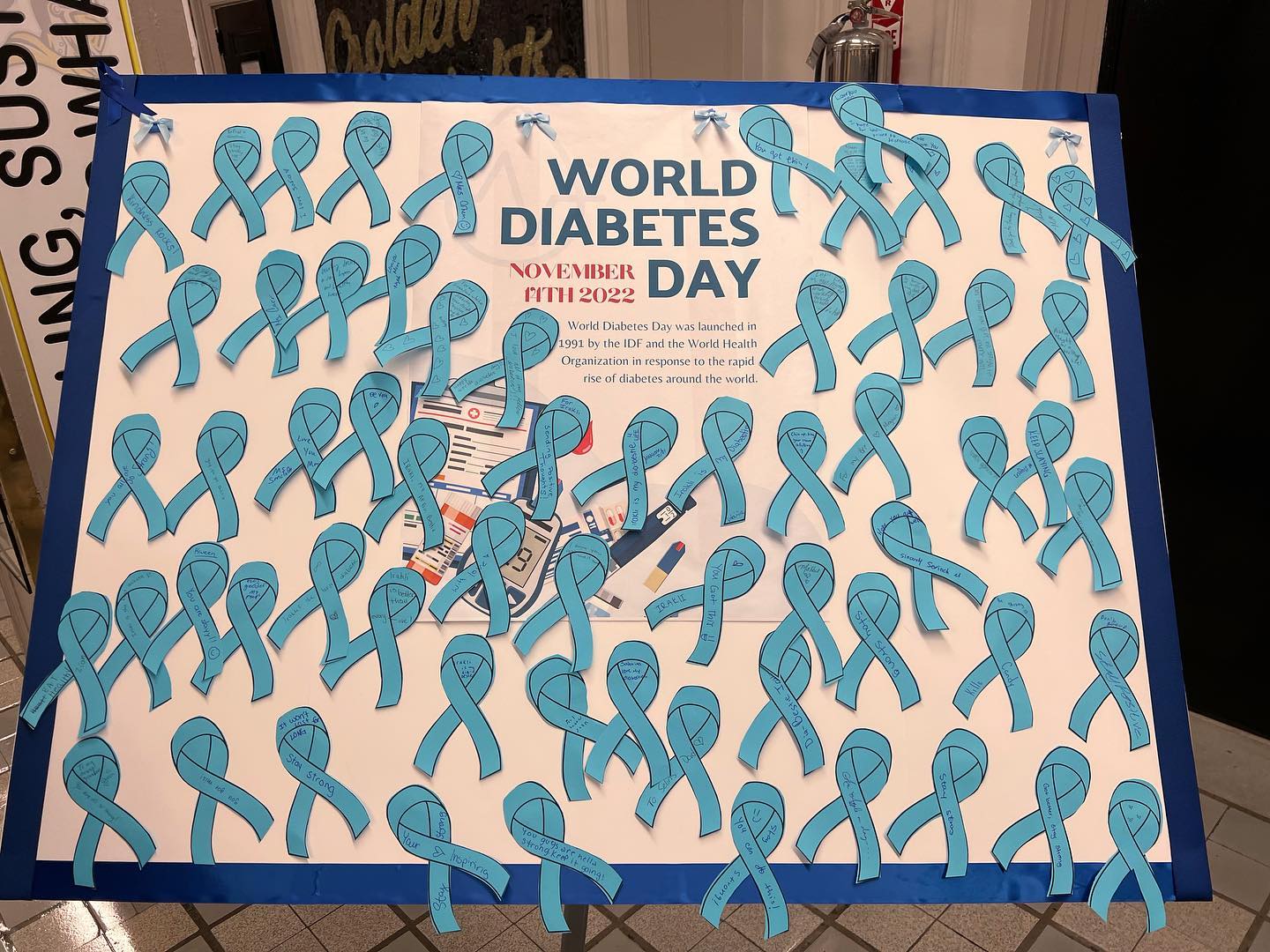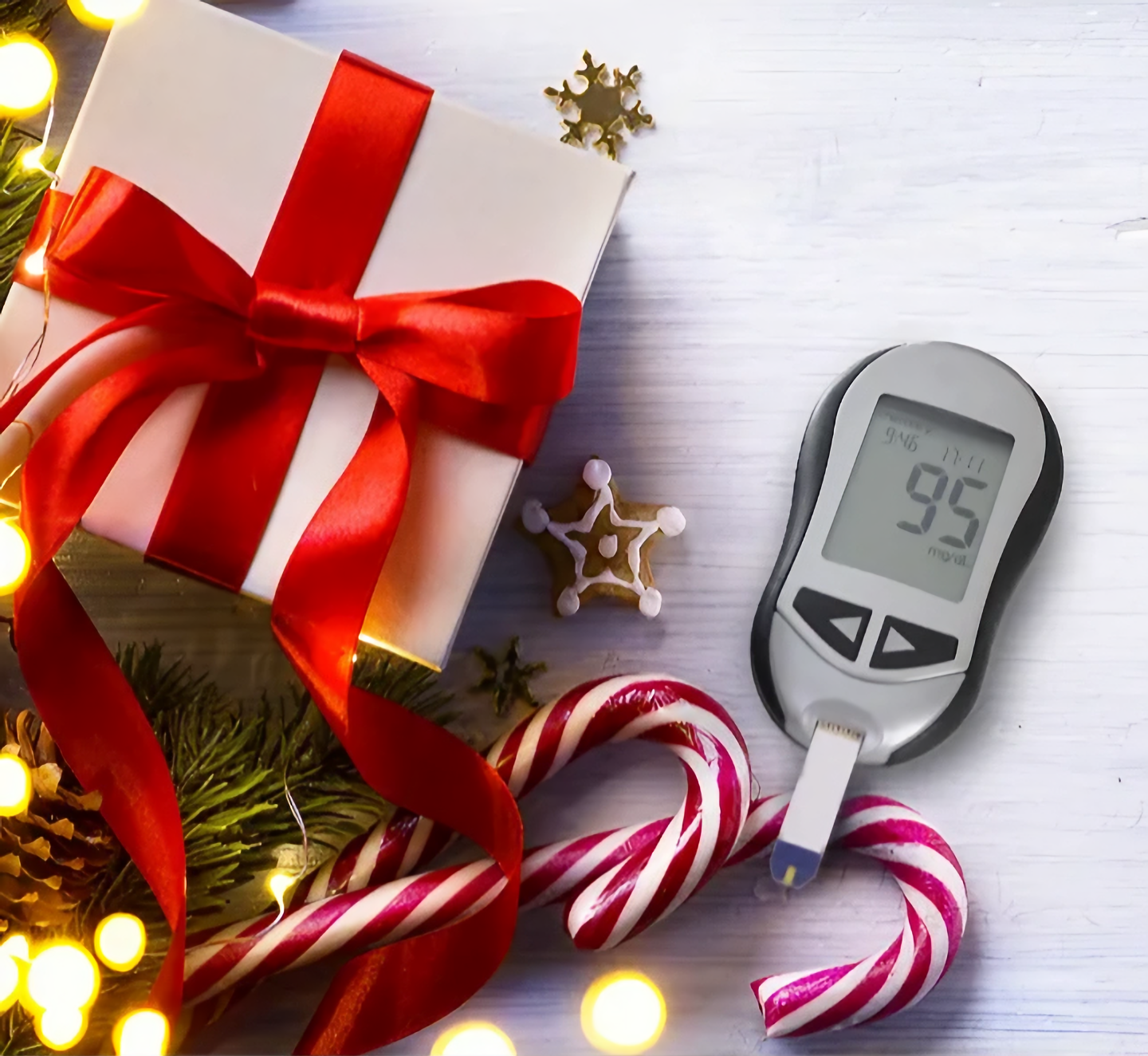For those who celebrate Thanksgiving, the Madison Highway hopes you had a good holiday. For many diabetics, November and December become the harshest months of the year. Because of holidays, maintaining a healthy blood sugar level while eating carbohydrate-heavy meals is very difficult. To stay healthy, everyone, diabetics, in particular, must eat in small portions, avoiding any food that might negatively impact their health. This November, Madison students spread Diabetes awareness by recognizing the struggles diabetics have to go through daily.
 On World Diabetes Day, Madison students wore blue and gave out informative brochures to all entering students.
On World Diabetes Day, Madison students wore blue and gave out informative brochures to all entering students.
 A poster board was placed in the main lobby, on which students could write and attach their ribbons full of supportive comments.
A poster board was placed in the main lobby, on which students could write and attach their ribbons full of supportive comments.
As November ends, let us reflect on the significance of Diabetes Awareness Month.
What Is diabetes?
Diabetes is an auto-immune disease that causes the body's immune system to attack the beta cells, which produce insulin in the body. Insulin is a substance produced in the pancreas that allows cells in the body to absorb glucose (sugar molecules) for energy. Without insulin, the body becomes acidic, and this causes it to turn fat into energy, leading to the release of ketones into the bloodstream. This process results in a state of ketoacidosis, which is deadly.
There are two types of diabetes: type 1 and type 2.
Type 1 diabetes is more common among younger children, although adults can have it too.
With type 1 diabetes, the pancreas produces little to no insulin, making the affected person insulin dependent. This means that the person relies on insulin that is in an insulin pen or vial and must regularly inject it.
Type 2 diabetes, on the other hand, is more common among adults. In this case, the body either does not produce enough insulin, or resists it. The types of treatment for type 2 diabetes vary from person to person.
The statistics
In the United States and around the world, the amount of people with diabetes disease is rising. The rate is at epidemic levels, with 1.4 million Americans being diagnosed with diabetes each year (American Diabetes Association). Diabetes is the seventh most deadly disease in the United States, and 8 out of 10 American adults aren't aware that they have pre-diabetes (CDC). It is estimated that between 420 million to 530 million people around the world have either type 1 or type 2 diabetes. Most cases develop in low- and middle-income countries.
Preventing diabetes
Type 1 diabetes is not preventable. Even those who eat healthy can begin getting high blood sugar and be diagnosed with the disease. However, there are some factors that catalyze having diabetes. Type 1 diabetes runs in people's families; therefore, you can be tested to make sure that you do not have diabetes, but it truly cannot be prevented. Some causes may include not getting enough sleep, eating mostly simple sugars (like candy and soda), and not exercising. While none of these lifestyle choices alone can directly give you type 1 diabetes, they can impact your body negatively and cause you to become more susceptible to type 2 diabetes, which is preventable. Although maintaining healthy habits are essential to leading a healthy life, it is especially important to be aware of your diet and exercise to prevent type 2 diabetes. Unlike type 1 diabetes, type 2 diabetes constitutes more clear preventative measures that can be taken. Unlike type 1 diabetes, if you sustain healthy life-style changes, type 2 diabetes can also be delayed and reversed to minimize the treatments needed for it.
Complications
The complications that come with diabetes are severe. If you are diagnosed with diabetes as a child, you are at risk for complications such as a heart attack, stroke, kidney failure, neuropathy (nerve damage), and even limb amputation. While this is not an extensive list, these serious and sometimes deadly conditions may help to explain what diabetics around the world must be mindful of. If a healthy blood sugar level is maintained however, then the probability of experiencing such complications early or later in life significantly decreases.
Treatment
There are numerous treatments and caretaking practices for diabetics. These include checking blood sugar levels, taking insulin, and taking oral medication. Diabetics prick their fingers with needles. Recent innovations in devices such as the continuous glucose monitor and the insulin pump have made it easier to manage diabetes through an artificial pancreas system. The glucose monitor measures blood sugar in real time using a sensor, and the insulin pump calculates and helps to consistently keep blood sugar down.
Treatment is often hard to receive without insurance, and even those who are insured often must pay high prices for only a month's supply. For example, just one of my two medicines costs almost $300 per month without insurance. With insurance, it is much cheaper—but not every diabetic has this luxury. In fact, millions have rationed insulin in America due to unaffordability. This is an enduring problem in American healthcare that should be fixed, and people’s lives should not be jeopardized because they cannot afford life-saving medications.
For anyone who wants to donate to the American Diabetes Association, you can do so here.
Thank you for your support this month!
